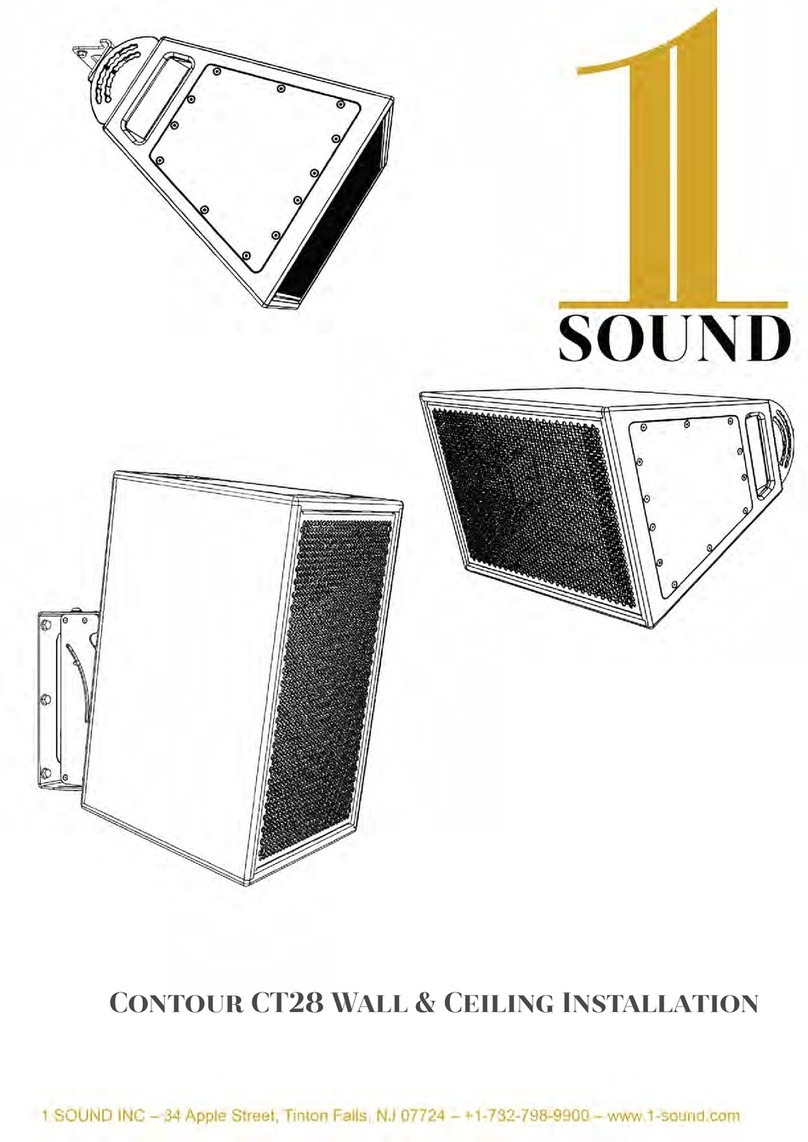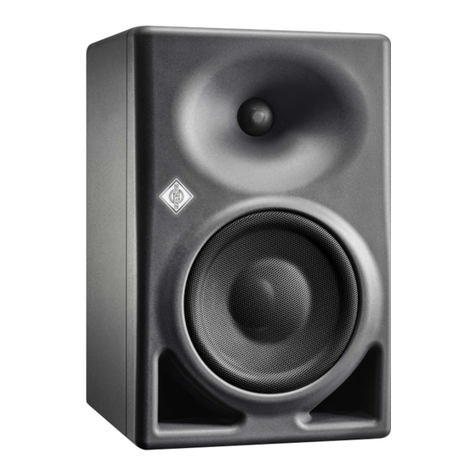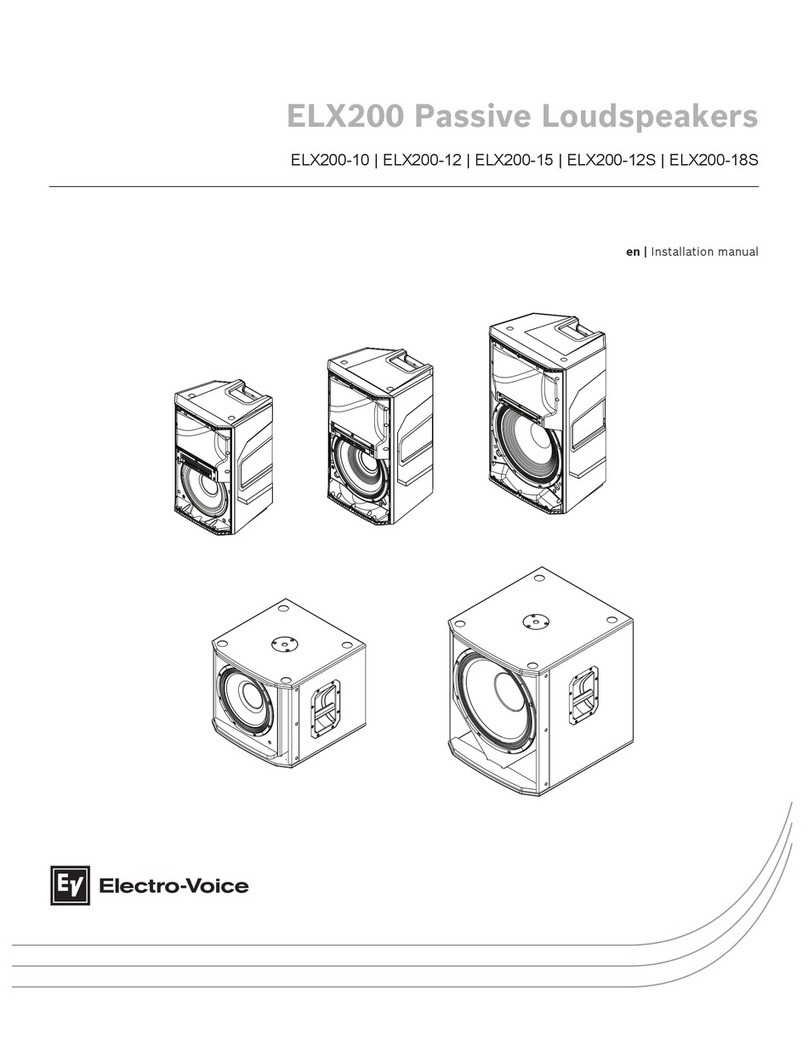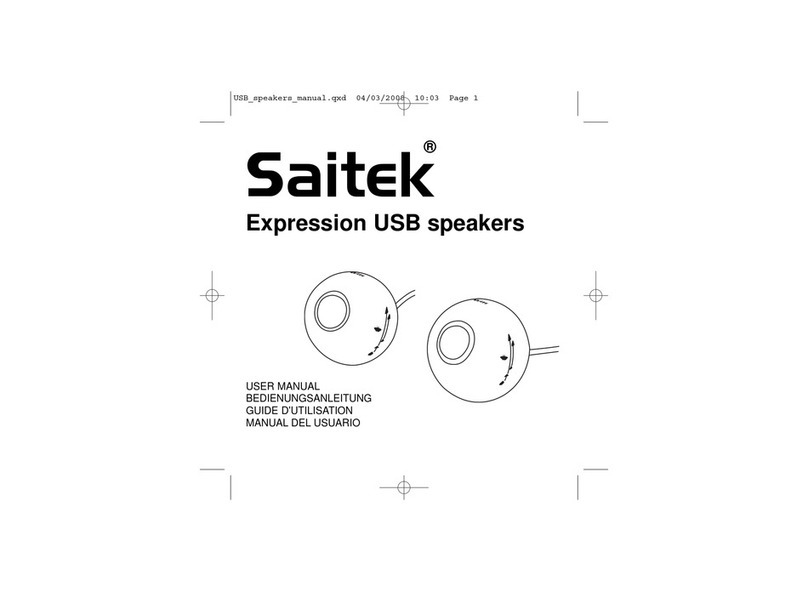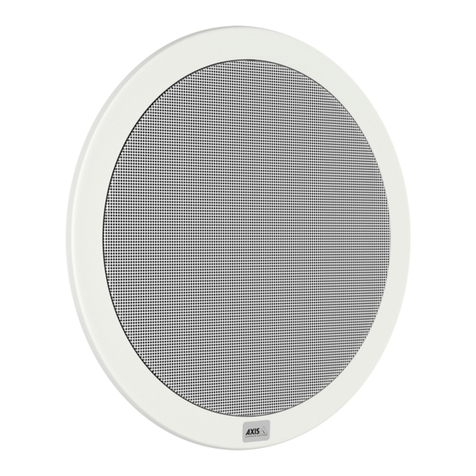1 Sound Tower Series User manual

WORKING DRAFT
1 SOUND INC – 34 Apple Street, Tinton Falls, NJ 07724 – +1-732-798-9900 – www.1-sound.com
Tower Series LCC44/LCC84 Wall Installation

Contents
Chapter 1. Speaker models................................................................3
TOWER LCC44..............................................................................3
TOWER LCC44 Specifications................................................3
TOWER LCC84..............................................................................3
TOWER LCC84 Specifications................................................3
Chapter 2. Accessories.......................................................................4
LCC44 Wall Bracket.......................................................................4
LCC84 Wall Bracket.......................................................................4
Chapter 3. Installing LCC44/LCC84 on a Wall Mount Bracket........5
Critical information..........................................................................5
Products, accessories and tools required...................................... 5
Procedures......................................................................................5
Disassembling the bracket......................................................5
Installing the bracket on the LCC44/LCC84 enclosure..........7
Installing a redundant safety anchor.......................................9
Mounting the bracket.............................................................10
Coupling the LCC enclosure and bracket to the mounting
plate.......................................................................................12
Redundant safety..................................................................14
Fixing the tilt angle................................................................14
Fixing the pan angle............................................................. 15

Chapter 1. Speaker models
TOWER LCC44
Cardioid Column Line Array Enclosure
Figure 1. LCC44 with Tower Rigging System (left),
and without.
Tower LCC44 is a cardioid line array element featuring designed to be
compact, high powered and array-able. The enclosure features Clarity
Technology©, a proprietary high frequency technology built around
four coaxial transducers each composed of a 4" cone driver and a
compression driver. The enclosure provides 120° horizontal coverage
on axis. Three additional rear 4" full-range transducers allow the unit
to provide a cardioid dispersion pattern with -20 dB rear cancellation.
The Towers can be deployed independently or combined using the
proprietary Tower Rigging System to create long column arrays. Each
LCC44 unit requires two amplifier channels operating with a dedicated
DSP preset in order to achieve the cardioid dispersion pattern.
TOWER LCC44 Specifications
Description Cardioid line array column featuring Clarity Technology© high
frequency
Bandwidth 105 Hz – 18 kHz (-6 dB)
Max SPL 123 dB SPL @ 1 m w/ preset (1 unit)
Power 800 watts front + 400 watts rear (continuous), 400 watts + 200
watts (AES)
Directivity 120° horizontal
Elements (4) 4" coaxial each with a 1.4" compression driver, (3) 4" rear-
facing full range
Impedance 16 Ω front speakers, 24 Ω rear speakers
Connectors (4) NL4, 1+/1- front, 2+/2- rear, each allowing for audio inputs
and linking
IP Rating IP55 indoor/outdoor and salt water resistant
Rigging Proprietary rigging elements and fly bars -3°, 0°, +3°, +6°,
+9°; (14) available M6 points
Weight 22 lb / 10 kg
Construction Finland birch plywood (phenolic glue), structural stainless
steel interior, polyurea, clear matte salt and UV resistant coat
ing, 316 stainless steel hardware, 3D spacer mesh fabric
Accessories LCC44 Wall Bracket, Tower Tube Mount, Tower Rigging Sys
tem, Fly Bar (Long & Short), Active Speaker Tube (various
lengths)
Dimensions 17.8" (452 mm) x 6.3" (160 mm) x 9.5" (240 mm)
Colors Stocking black and white, custom colors and fabrics available
TOWER LCC84
Cardioid Column Line Array Enclosure
Figure 2. LCC84 with Tower Rigging System (left),
and without.
Tower LCC84 is a cardioid line array element featuring designed to be
compact, high powered and array-able. The enclosure features Clarity
Technology©, a proprietary high frequency technology built around
eight coaxial transducers each composed of a 4" cone driver and a
compressiondriver.The enclosure provides120° horizontal coverageon
axis. Six additional rear 4" full-range transducers allow the unit to provide
a cardioid dispersion pattern with -20 dB rear cancellation. The Towers
can be deployed independently or combined using the proprietary Tower
Rigging System to create long column arrays. Each LCC84 unit requires
two amplifier channels operating with a dedicated DSP preset in order to
achieve the cardioid dispersion pattern.
TOWER LCC84 Specifications
Description Cardioid line array column featuring Clarity Technology© high
frequency
Bandwidth 105 Hz – 18 kHz (-6 dB)
Max SPL 127 dB SPL @ 1 m w/ preset (1 speaker)
Power 1600 watts front + 800 watts rear (continuous), 800 watts +
400 watts (AES)
Directivity 120° horizontal
Elements (8) 4" coaxial each with a 1.4" compression driver, (6) 4" rear-
facing full range
Impedance 8 Ω front, 12 Ω rear
Connectors (4) NL4, 1+/1- front speakers, 2+/2- rear speakers, each al
lowing for audio inputs and linking
IP Rating IP55 indoor/outdoor and salt water resistant
Rigging proprietary rigging elements and fly bars -3°, 0°, +3°, +6°, +9°;
(14) available M6 points
Weight 43 lb / 19.5 kg
Construction Finland birch plywood (phenolic glue), structural stainless
steel interior, polyurea, clear matte salt- and UV-resistant
coating, 316 stainless steel hardware, 3D spacer mesh fabric
Accessories LCC84 Wall Bracket, Tower Tube Mount, Tower Rigging Sys
tem, Active Speaker Tube
Physical 36.8" (934 mm) x 6.3" (160 mm) x 9.5" (240 mm)
Colors Stocking black and white, custom colors and fabrics available

Chapter 2. Accessories
LCC44 Wall Bracket
Figure 3. LCC44 Wall Bracket
The LCC44 Wall Bracket attaches to an LCC44 Tower loudspeaker in
order to mount to a wall or ceiling. To provide versatility in terms of
installation and to adapt to the coverage requirements of the speaker
enclosure, the bracket is articulated on two axes, with 180° (±90°)
horizontal orientation and 40° of vertical tilt. The bracket is designed to
facilitate installation by a single person and is available with a black or
white finish as standard.
The kit includes:
•The assembled wall bracket
LCC84 Wall Bracket
Figure 4. LCC84 Wall Bracket
The LCC84 Wall Bracket attaches to an LCC84 Tower loudspeaker in
order to mount to a wall or ceiling. To provide versatility in terms of
installation and to adapt to the coverage requirements of the speaker
enclosure, the bracket is articulated on two axes, with 180° (±90°)
horizontal orientation and 40° of vertical tilt. The bracket is designed to
facilitate installation by a single person and is available with a black or
white finish as standard.
The kit includes:
•The assembled wall bracket

Chapter 3. Installing LCC44/LCC84
on a Wall Mount Bracket
Critical information
Attention: This wall-mount bracket is intended for installation by
qualified professionals.
Notice: Please read these instructions carefully and completely
before attempting installation.
WARNING
Improper installation or suspension of any heavy load
can result in death or serious injury to persons, as well
as damage to property.
It is the responsibility of the installation personnel to
verify and guaranty the reliability and safety of the
installation.
Notice: This product must be installed in compliance with all
applicable local, state and national regulatory provisions. The
responsibility rests with the installer to verify that the installation
is carried out in accordance with any applicable legislation.
Important: The installer must assess the appropriate stability
andsturdiness ofthe mountingsurface.Inthecase ofwall-mount
and ceiling-mount brackets, this includes, but is not limited to
verifying the positions of suitable studs in the case of drywall
mounts, hollow points in concrete block or solid concrete, as well
as the presence and vicinity of electrical wiring or plumbing.
Restriction: Only hardware and accessories included with
the product or specified by 1 Sound should be used for its
installation.
Restriction: Do not modify or alter the loudspeaker or any
accessory. Any modification by the user or installer could render
the product or the installation unsafe.
Restriction: Do not install a loudspeaker or any accessory near
any open flame or heat source.
Products, accessories and tools required
ToinstallanLCC44orLCC84enclosurepermanentlyonawallorsurface
you will need the following:
•An LCC44 (on page 3) or LCC84 (on page 3) loudspeaker
enclosure
•The corresponding LCC44 (on page 4) or LCC84 Wall Mount
Bracket (on page 4) kit
•An appropriate power drill and bit for the installation surface
material
•A 5 mm hex (Allen) wrench
•Medium-duty mounting screws or bolts appropriate to the
mounting surface (coach screws for drywall studs, concrete
screw anchors for concrete or masonry, etc.); screws and bolts
should have a flanged head or a coupled washer ø14-16 mm in
order to retain the mounting plate
•Appropriate tools for securing the aforementioned fasteners
(power screwdriver etc.)
•A Torque wrench
•Optional: 4 mm hex (Allen) wrench, steel rope sling or chain, M6
lifting eye bolt (shouldered type); eye bolt spanner or driver
•Recommended: pencil or marker, spirit level, stud finder
Procedures
Disassembling the bracket
The Wall Mount Bracket ships fully assembled, but to facilitate
installation, it should first be separated into two parts, the bracket itself
and the wall-mount plate. Before disassembly, be sure to note the proper
interlocking configuration of the tilt mechanism; this will remove doubts
when it is time to reassemble the bracket.
Figure 5. Loosening the tilt lock.
•Makesure thatthetiltmechanismcan movefreely. Ifit doesnot,
use a 5 mm hex wrench to loosen slightly the horizontal hex-
head bolt near the top of the tilt/pan mechanism. The bracket
should be free to tilt, but this bolt should remain in place.

TOWER SYSTEM LCC44/LCC84 WALL INSTALLATION
Figure 6. Removing the R-clip from the clevis pin.
•RemovetheR-clip(hairpincotter)fromtheclevispinthatserves
as a pivot axle for the tilt mechanism, and remove this clevis
pin. Put the pin and the R-clip aside, as they will be required to
complete the installation.
Figure 7. Removing the clevis pin from the tilt
mechanism.
•Tilt the bracket outwards from the mounting plate until it comes
to a stop at its maximum tilt.
Figure 8. Removing the bracket from the mounting
plate.
•The bracket should come away easily towards the bottom of the
mount.

| 3 - INSTALLING LCC44/LCC84 ON A WALL MOUNT BRACKET
Installing the bracket on the LCC44/LCC84 enclosure
Once the bracket has been separated from the wall-mount plate, it can
be easily attached to the LCC44 or LCC84 enclosure.
Important: For permanent or semi-permanent installation,
the use of medium-strength threadlocking compound is
recommended on all user-installed screws.
Figure 9. The rear panels of the LCC44 (left) and
LCC84 with the mounting points for the bracket
indicated.
Figure 10. Removing the M8 x 20 mm screws for the
installation of the bracket (LCC44 shown).
•Lay the enclosure on its front grille, taking whatever necessary
precautions to avoid damaging the finish of the cabinet or the
grille.Although theLCC44 andLCC84 unitshave asymmetrical
vertical coverage and there is no "top" or "bottom" acoustically,
if the front grille is equipped with a logo plate you should note
its orientation and for aesthetic reasons, and make sure that
the bottom of the logo plate will be towards the bottom of the
enclosure when it is installed.
•Using a 5 mm hex wrench, remove the two button-head M8 x
20 mm screws from the two connection panels, between each
pair of SpeakOn connectors on the rear of the enclosure. Keep
them, as they will be used to mount the bracket.

TOWER SYSTEM LCC44/LCC84 WALL INSTALLATION
Figure 11. Positioning the bracket and aligning the
mounting holes.
•Place the bracket over the rear of the enclosure, aligning the
two mounting holes in the bracket with the threaded holes in
the connection panels. Be sure to orient the bracket with the
attachment for the wall-mount plate towards the end of the
enclosure that will be on the bottom when it is installed.
Figure 12. Inserting the lower screw through the
bracket.
•Insert one of the M8 x 20 mm screws previously removed, and
thread it into the bottom (toward floor) panel of the enclosure
through the mounting hole in the bracket.
Figure 13. Inserting the upper screw through the
bracket.
•The upper end of the bracket can be secured using the second
M8 x 20 mm screw previously removed. Insert the screw and
thread it into the top (toward ceiling) panel of the enclosure
through the upper mounting hole in the bracket.
Figure 14. Tightening the screws to fix the
mounting bracket (LCC44 shown).
•Using a 5 mm hex wrench (Allen type) with a length that allows
for sufficient leverage, firmly tighten the screws into the panels,
makingsurethattheir canbenomovementbetweenthebracket
and the speaker enclosure.

| 3 - INSTALLING LCC44/LCC84 ON A WALL MOUNT BRACKET
Installing a redundant safety anchor
Attention: When correctly installed, the Wall Mount Bracket
is designed to safely support The LCC44 or LCC84 speaker
enclosure under normal conditions. However, connection to an
external anchor point using a steel wire rope safety sling or chain
is strongly recommended in any installation where people could
pass beneath or near the loudspeakers and may be required
by local or national codes in installations in public places. If you
intend to install a secondary safety sling anchored directly to
the enclosure, it is recommended that you use one of the M6
rigging points on the top of the LCC44 or LCC84 enclosure for
this purpose.
In most cases of wall mounting a single LCC44 or LCC84 enclosure, the
use of a common, steel wire rope sling will provide sufficient redundant
safety. Carefully review the third-party manufacturer's documentation to
assure that the sling and all its components are certified for the proper
Safe Working Load with the required Factor of Safety. The length of the
sling and termination on the opposite end will obviously depend on the
requirements of the structure to which it will be anchored.
It will be necessary to install an eye bolt in one of the M6 rigging points in
the place of the M6 × 16 mm screw supplied with the speaker enclosure.
Only a forged steel eye bolt with a collar or shoulder, certified for the
proper Safe Working Load with the required Factor of Safety at its
minimum load angle can be used.
Important: For permanent or semi-permanent installation,
the use of medium-strength threadlocking compound is
recommended on all user-installed screws.
Figure 15. M6 Eye bolt measurement requirements.
Figure 16. Removing the M6×16 mm countersunk
screw for the installation of a safety anchor.
•Using a 4 mm hex wrench, remove one of the M6×16 mm
countersunk screws from the top pf the LCC44 or LCC84
enclosure. Though any one of these rigging points is capable of
supporting the enclosure, it is good practice to use one of the
rigging points nearer the horizontal center of the enclosure and
nearest one in a straight line to the external anchor point.
Figure 17. Inserting an M6 eye bolt
in the rigging point on the top of the
LCC44/84 enclosure.
•Thread the M6 eye bolt into the rigging point from which the
screw was removed and tighten it with your fingers.
Figure 18. Tightening the eye bolt.
Figure 19. Tightening the eye bolt.
•Using a slotted socket or eye bolt spanner, firmly tighten the
eye bolt.

TOWER SYSTEM LCC44/LCC84 WALL INSTALLATION
Mounting the bracket
The mounting plate of the LCC44/84 Wall Bracket must be firmly fitted to
the wall or surface before mounting and pointing the speaker enclosure.
WARNING
Before beginning this installation, it is necessary to
ascertain the construction type, load-bearing capability
and durability of the wall or surface. Bear in mind that
the LCC44 speaker enclosure weighs 10 kg (22 lb)
and LCC84 weighs 19.5 kg (43 lb). The Wall Mount
Bracket is also capable of downward tilt that extends
the mass of the enclosure up to a 40° angle out from
the mounting surface. Therefore, the increased forces
imposed on the fixings and wall must be taken into
account.
Careful thought must be given to ensure that the
wall structure is strong enough to safely support the
total load with the proper Factor of Safety required
by local, state and national norms or legislation. If
the facility or venue is open to the public and the
mount is within reach of the public, the installer should
take into consideration possible miscreant behavior or
tampering when determining the appropriate factor of
safety. If the wall structure is deemed incapable of
supporting the load, consideration should be given to
strengthening and/or stabilizing the wall or adopting
an alternative method of installation. In the case of
any doubt, architects, structural engineers or other
specialists should be consulted.
WARNING
Risk of Electric Shock
Drilling into hidden electrical wiring within walls can
result in serious injury or death, fires and property
damage.
BE AWARE OF WHAT YOU ARE DRILLING INTO.
Before drilling holes in any wall or surface, make sure
that it does not conceal electrical wiring or conduits.
Consult the wiring diagram of the facility or venue and
check for nearby outlets, switches or junction boxes
that could indicate concealed wiring, be it electrical
mains, network, telephone or other infrastructure.
CAUTION
Use Proper Eye, Ear, Head, Foot and Hand Protection
During Installation
This task may require the use of power tools and
potentially elevated loads.
Alllocalandnationalnorms, regulationsandguidelines
must be followed during the installation procedures,
including the use of proper protective clothing and
gear.
Notice: Due to the wide variety of building materials and
construction methods that can be encountered in an installation,
1Sound canonly providegeneralrecommendationsforinstalling
the Wall Mount Bracket. It is the responsibility of the installer to
assess the appropriate stability and sturdiness of the installation.
This includes verifying the positions of suitable studs, posts
or framing in the case of drywall mounts, verifying hollow
points in masonry, concrete block or solid concrete, and
utilizing anchoring methods and hardware appropriate for safe
installation of the equipment according to the construction
material and depth of the mounting surface. The responsibility
rests with the installer to verify that the installation is carried
out in accordance with any applicable legislation. In case of any
doubt, architects, structural engineers or other specialists should
be consulted.
Notice: In the case of installation in solid concrete, concrete
block or masonry structures, due to the size of the mounting
plate and the narrow distance between the mounting holes
in the plate, the use of expansion anchors (sleeve anchors,
wedge anchors, plastic anchors etc.) is not recommended, as
the proximity between them is likely inferior to safe spacing
practices for this type of fastener, and could potentially weaken
the mounting surface. Verify the building material, as well as
its depth and condition to determine the appropriate anchoring
system. Make sure that the fasteners include washers or have
flanged heads with adequate outer diameter (from 14 mm to 16
mm) to firmly hold the mounting plate around the holes. Consult
the specifications of the third-party hardware and carefully follow
the instructions of the manufacturer to determine the appropriate
drilling depth, bit diameter, necessary spacing and any further
specific instructions or additional necessary procedures.
Important: In the case of a wall constructed of drywall or
other panels on a wooden stud frame, it is extremely important
to verify that the desired installation point has sufficient solid
backing to support the installed speaker enclosure. DO NOT
install the mount on unbacked drywall, plywood or plastered
lath. A studfinder can be useful for this, but it is better to know
the exact layout of the frame beforehand. The center-to-center
width between the mounting holes of the Wall Mount Bracket is
1.89" (48 mm), and therefore wider than standard 2x4 (1.5" x
3.5") or 2x6 (1.5" x 3.5") wooden framing studs. Therefore, it is
onlypossibletomounttheplate ontootherframing memberswith
doubled or wider widths, such as doubled posts or column studs,
corner posts, doubled jamb/king studs, solid lintels, or purpose-
built internal framing. Be careful to assure that all four mounting
holes will be drilled into the solid wood frame. Joints between
singlestuds andsingle horizontalnoggings orfireblocks couldbe
deceptive and provide a mounting position with only three of the
screws in solid wood and the fourth only in drywall – an unsafe
condition.
Be sure to verify the depth of drywall (commonly 0.5 inches or
6.35 mm) in front of the load-bearing studs and consider this
in selecting the length of the fastener necessary. Consult the
specifications of the third-party hardware to verify the necessary
depth to guarantee the required safety factor, but remember that
it is unwise and potentially hazardous to exceed the depth of the
framing member into which the anchor is driven.

| 3 - INSTALLING LCC44/LCC84 ON A WALL MOUNT BRACKET
Figure 20. The wall-mount plate of the LCC44/84
Wall Bracket
Figure 21. Marking the mounting surface for
drilling.
•When it has been verified that there is no wiring or plumbing
in the wall behind the mounting position, use the plate itself
as a drilling template and mark with the pencil the centers and
outlines of the mounting holes. A spirit level can be useful to
assure that the mount is properly leveled.
Figure 22. Drilling the mounting holes .
•Drill the four holes, using a drill or percussion drill with a bit
approriate to the substrate material (masonry/concrete, wood,
steel etc.) with the appropriate diameter and to the appropriate
depth for the anchor type being used.
•Once the four mounting holes have been drilled, clear them of
residue and verify the appropriate depth of each.
•Place the mounting plate against the wall in the correct
orientation (with the hole for the removed clevis pin on the
bottom) and align the four mounting holes centered on the
drilled holes.
•Insert the four screws or anchors directly through the mounting
holesin theplate, tighteningthescrewanchorswith yourfingers
only sufficiently to keep them in place.

TOWER SYSTEM LCC44/LCC84 WALL INSTALLATION
Figure 23. Driving the screw anchors into the wall.
•Whileholding theplate inplace,useasocket wrenchor apower
screwdriver to tighten each fastener gradually, alternating
diagonally opposed fasteners in an "X" pattern until each holds
the plate to the wall. When using a power driver, keep it at a
low speed to avoid stripping the threading cut into the substrate
material. Once the washer or flanged head on each bolt is in
contact with the plate and the plate is against the wall, continue
tightening them only by hand.
Figure 24. Tightening the screw anchors with a
torque wrench.
•Using a torque wrench, tighten each screw anchor into the
wall. Take care not to exceed the maximum installation torque
specified by the manufacturer of the hardware.
Figure 25. Applying downward force to verify the
mount.
•Apply force or weight to the mounting plate to physically verify
its ability to support the necessary load. There must be no
movement possible between the plate and the wall.
Coupling the LCC enclosure and bracket to the mounting
plate
Once the mounting bracket has been installed on the LCC84 or LCC44
and the mounting plate has been secured to the mounting surface, the
speaker enclosure can be mounted on the wall.
Figure 26. Installing the LCC44 with the bracket
onto the mounting plate.

| 3 - INSTALLING LCC44/LCC84 ON A WALL MOUNT BRACKET
Figure 27. Installing the LCC44 with the bracket
onto the mounting plate, overhead view.
•Lift the LCC44/84 enclosure with the bracket installed up to the
mounting plate on the wall. Carefully insert the tilt arms that
extend from the rear of the bracket in between the outer and
inner plates of the pan/tilt mechanism, and around the bolt that
locks the tilt.
Figure 28. Inserting the clevis pin.
•While maintaining a firm grip on the speaker enclosure, tilt it up
towards the mounting surface and align the holes in the bracket
with the holes in the lateral plates of the pan/tilt mechanism
(below the bolt that locks the tilt) and insert the clevis pin
completely through these holes until it protrudes from the other
side of the mount.
Figure 29. Replacing the R-Clip.
•Replace the R-clip (hairpin cotter) completely through the hole
in the clevis pin until it snaps into place.
Figure 30. Lowering the Speaker enclosure to its
maximum tilt.
•At this point, the speaker enclosure is secured to the mount.
Slowly lower the speaker enclosure until it stops at 40°. You
can now safely release the speaker enclosure and proceed with
securing the redundant safety cable and fixing the tilt and pan
angles.

TOWER SYSTEM LCC44/LCC84 WALL INSTALLATION
Redundant safety
If the LCC44 or LCC84 speaker enclosure has been equipped with an
eyeboltfor a redundantsafetycable (steel wireropesling or steelchain),
this should be attached to the external anchor before proceeding with the
pan/tilt positioning of the enclosure on the Wall Mount Bracket.
ATTENTION
A redundant safety sling must be anchored to a point higher than the
enclosure and, if possible, to a separate structural member than the
Wall Mount Bracket. If the secondary safety sling must be anchored
using a fastener to the same structural member as the Bracket,
its anchor must be installed at least one speaker-length away from
the anchors holding the Bracket. Use only steel wire ropes or steel
chains that conform to applicable regulations or norms in terms of
construction and Safe Working Load rating. These must be of proper
length and installed in such a position as to prevent the enclosure
from falling more than 20 cm in the case of failure of the Bracket or
the structure to which it is installed.
Figure 31. Passing a wire rope safety sling through
the eye bolt.
•If using an installed eye bolt, pass one end of the sling through
the eye bolt mounted on the rear of the enclosure.
Figure 32. Securing the redundant safety sling.
•Pass the opposite end of the sling through an external anchor
point or around a structural member and assure that it is
properly secured.
Fixing the tilt angle
Once the clevis pin that acts as the pivot axle for the tilt mechanism has
been inserted and secured with the R-clip, you can set the required pan
and tilt angles. It is advisable to set the tilt angle first, as certain pan
angles could obstruct access to the tilt lock bolt. In fact, to allow ample
space for tightening the tilt lock, it is convenient to rotate the entire mount
as far as the mounting surface will allow in pan to the left (as seen from
the front) before setting the tilt angle.
Figure 33. The pan lock bolt, from above.

| 3 - INSTALLING LCC44/LCC84 ON A WALL MOUNT BRACKET
Figure 34. Releasing the pan lock bolt.
•Use a 5 mm Hex wrench to loosen the pan lock bolt on the top
of the Wall Mount Bracket.
•Rotate the enclosure to the left to allow clear access to the tilt
lock bolt.
Figure 35. Locking the tilt angle.
•Adjust the tilt of the enclosure to the required angle and keep
a firm hold on it.
•Firmly tighten the tilt lock bolt using a 5 mm Hex wrench.
•Release the speaker enclosure and assure that the chosen
angle remains firm.
Fixing the pan angle
Withthetilt angle locked, settingthe pan angle isas simple as turningthe
LCC44 or LCC84 enclosure to the desired angle and locking it in place
by tightening the pan lock bolt.
Note: The panning range of the Wall Mount Bracket is ±90° from
the center. However, this range may be limited on one or both
sides by the mounting surface, due to the width of the rear panel
of the LCC44 or LCC84 enclosure. If the Bracket is installed on
a flat wall, the mount will allow approximately ±65° of panning
range, depending on the tilt angle.
Figure36. Panningrange limiton acontinuous wall,
view from above.
•Rotate the enclosure to the desired horizontal orientation.
Figure 37. Tightening the bolt to lock the pan angle.
•Using a 5 mm hex wrench, firmly tighten the pan lock bolt until
the enclosure is locked in the desired position.

1 SOUND INC
34 Apple Street
Tinton Falls, New Jersey 07724
U.S.A.
tel: +1-732-798-9900
© 2022 1 SOUND
All rights reserved.
No part of this publication may be reproduced or transmitted in any form
or by any means without the express written consent of the publisher.
This manual suits for next models
2
Table of contents
Other 1 Sound Speakers manuals
Popular Speakers manuals by other brands
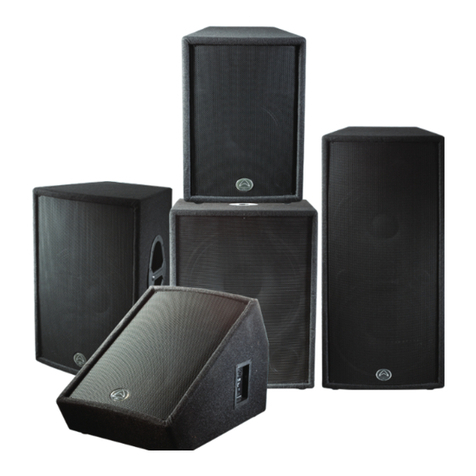
Wharfedale Pro
Wharfedale Pro SVP-X Series Operating manual and user guide
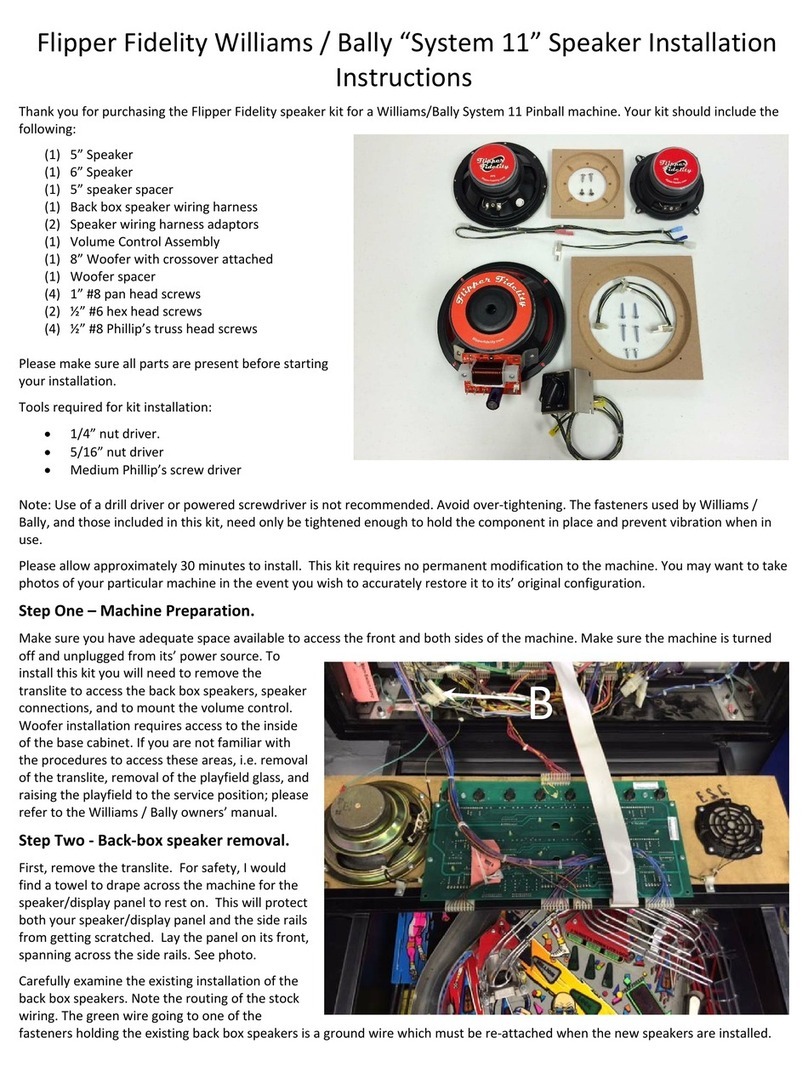
Flipper
Flipper Bally System 11 installation instructions

Anchor
Anchor MegaVox PRO MEGA-6000 Specifications
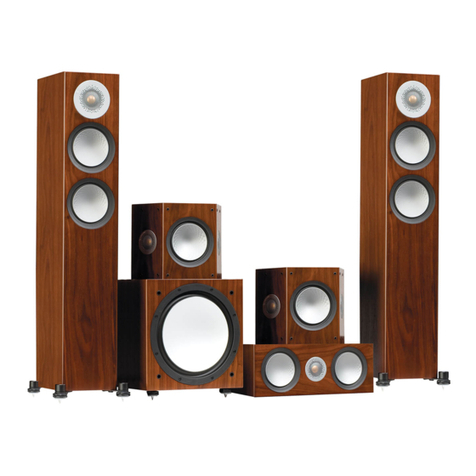
Monitor Audio
Monitor Audio Silver series owner's manual

American Audio
American Audio CPX user guide

Monacor
Monacor img stage line instruction manual
